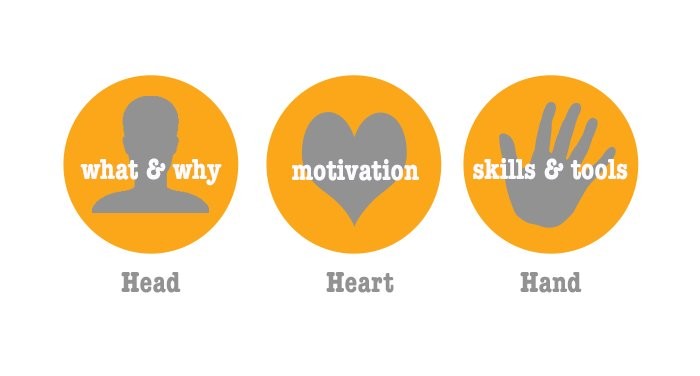
Hands, Head & Heart – the 21st Century leadership trinity.
“You cannot delegate culture change. The culture is not “out there ” somewhere; it is in you — in your gut, your heart, and your mind. You can no more have someone else change the culture for you than you can have someone else change your mind. It is that fundamental. If you want others to commit, then you commit first. If you want others to adapt and change, then take the lead.”
Employee engagement is shaping up to be the leadership challenge for the early 21st Century. In a world defined by accelerating, ceaseless change how we as leaders connect, communicate and inspire those we serve in our organisations will matter more than how work is done. The why overrides the what and how. The why is about culture and as the saying goes, culture eats strategy for breakfast. And culture is the leader’s true business.
Hands perform their job duties because they are told to. Heads perform their duties because they know that they are supposed to. Hearts perform their duties because they want to because of their love of their job and those for whom they are performing their services.
Hands can expand their skills to include Head qualities with time, encouragement, and technical proficiency. Both Hands and Heads can expand their skills and behaviours to include Heart traits with empowerment, clear communication of process reasons and end goals, respect, recognition, sharing successes, and an understanding of the broader impact of their contribution, both corporately and to the client.
Head represents the concern for direction. It comprises behaviours by which the leader understands business, sets direction, solves problems and makes decisions.
Heart represents the concern for energy, and is divided into three categories:
- Enabling Others: the interpersonal aspect of leading with emotional intelligence.
- Enabling Self: the personal aspects of emotional intelligence.
- Enabling Groups and the Organisation: the effective use of influence, and ensuring that people can work together constructively and creatively.
Hands represents the concern for achieving goals. It deals with holding people and processes accountable and ensuring that they perform and are iteritively developed.
Most leaders are not all head, hands or heart – most are some combination. Even leaders who have all three in seemingly equal measures have some pitfalls to watch out for. The point is not to change who we are fundamentally, but rather to embrace our strengths, shore up our blind spots and adapt our styles to be more effective when leading across a variety of different people and situations. What is your dominant style? What are the strengths and weaknesses of this style?
The deep cultural level, where the Head and the Heart exist is the basis of how people work. It includes values (company and individual), norms (acceptable and unacceptable behaviours – both explicit and implicit), identity (connections and niche), as well as relationships and attitudes. Since change is dynamic, the approach used to help further the change must also be dynamic. If leadership is an act of service not a title, how do we show up, stand up and own up to connect with our staff? What kind of engagement is required to ensure your organisation’s future?
Sam.


No Comments